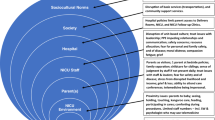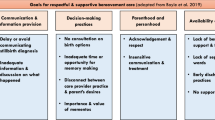Abstract
Objective:
To investigate circumstances of primary palliative care (PPC) in the delivery room (DR), medical personnel’s experience with neonates who died under PPC in the DR and perceived sources of care-related distress in DR staff.
Study Design:
Retrospective chart review of all neonates who were cared for under PPC in the DR during the years 2000–2010 at Charité University Medical Center Berlin, and structured face-to-face interviews with DR nursing staff and physicians.
Result:
Neonates undergoing PPC could be grouped as preterm infants at the limits of viability with a gestational age between 22 0/7 and 23 6/7 weeks (n=86, 76%) and newborn infants with complex chronic conditions (n=27, 24%). The median age of neonates at death was 59 min (interquartile range [IQR] 28–105 min). Most of DR staff did not report relevant signs of distress in dying neonates, and providing palliative care was not named as a relevant care-related source of distress by medical personnel. However, half of the participants reported on high degrees of caregiver’s emotional distress in PPC situations, identifying insecurity of how to communicate with parents and to provide emotional support as the most common source of distress.
Conclusion:
Caregiver’s emotional distress primarily originates from providing support to parents and not from providing medical care to the dying newborn. Implications for future practice include the need for structured education to improve DR staff's communication and counselling skills related to parents in PPC situations.
This is a preview of subscription content, access via your institution
Access options
Subscribe to this journal
Receive 12 print issues and online access
$259.00 per year
only $21.58 per issue
Buy this article
- Purchase on Springer Link
- Instant access to full article PDF
Prices may be subject to local taxes which are calculated during checkout
Similar content being viewed by others
References
Cortezzo DE, Sanders MR, Brownell EA, Moss K . End-of-life care in the neonatal intensive care unit: experiences of staff and parents. Am J Perinatol 2015; 32: 713–724.
Cortezzo DE, Sanders MR, Brownell E, Moss K . Neonatologists' perspectives of palliative and end-of-life care in neonatal intensive care units. J Perinatol 2013; 33: 731–735.
Kain VJ . Palliative care delivery in the NICU: what barriers do neonatal nurses face? Neonatal Netw 2006; 25: 387–392.
Williams C, Cairnie J, Fines V, Patey C, Schwarzer K, Aylward J et al. Construction of a parent-derived questionnaire to measure end-of-life care after withdrawal of life-sustaining treatment in the neonatal intensive care unit. Pediatrics 2009; 123: e87–e95.
Moro T, Kavanaugh K, Okuno-Jones S, Vankleef JA . Neonatal end-of-life care: a review of the research literature. J Perinat Neonatal Nurs 2006; 20: 262–273.
Walther FJ . Withholding treatment, withdrawing treatment, and palliative care in the neonatal intensive care unit. Early Hum Dev 2005; 81: 965–972.
Singh J, Lantos J, Meadow W . End-of-life after birth: death and dying in a neonatal intensive care unit. Pediatrics 2004; 114: 1620–1626.
Garten L, Deindl P, Schmalisch G, Metze B, Bührer C . Parallel assessment of prolonged neonatal distress by empathy-based and item-based scales. Eur J Pain 2010; 14: 878–881.
Janvier A, Meadow W, Leuthner SR, Andrews B, Lagatta J, Bos A et al. Whom are We Comforting? An Analysis of Comfort Medications Delivered to Dying Neonates. J Pediatr 2011; 159: 206–210.
El Sayed MF, Chan M, McAllister M, Hellmann J . End-of-life care in Toronto neonatal intensive care units: challenges for physician trainees. Arch Dis Child Fetal Neonatal Ed 2013; 98: F528–F533.
Yam BM, Rossiter JC, Cheung KY . Caring for dying infants: experiences of neonatal intensive care nurses in Hong Kong. J Clin Nurs 2001; 10: 651–659.
Kain VJ . Moral distress and providing care to dying babies in neonatal nursing. Int J Palliat Nurs 2007; 13: 243–248.
Catlin A, Armigo C, Volat D, Vale E, Hadley MA, Gong W, Bassir R et al. Conscientious objection: a potential neonatal nursing response to care orders that cause suffering at the end of life? Study of a concept. Neonatal Netw 2008; 27: 101–108.
Malterud K . The art and science of clinical knowledge: evidence beyond measures and numbers. Lancet 2001; 358: 397–400.
Miles B, Huberman A . Qualitative Data Analysis. Sage Publications: Thousand Oaks, CA, 1994.
Stephens BE, Tucker R, Vohr BR . Special health care needs of infants born at the limits of viability. Pediatrics 2010; 125: 1152–1158.
Feudtner C, Christakis DA, Zimmerman FJ, Muldoon JH, Neff JM, Koepsell TD . Characteristics of deaths occurring in children’s hospitals: implications for supportive care services. Pediatrics 2002; 109: 887–893.
Carter BS, Howenstein M, Gilmer MJ, Throop P, France D, Whitlock JA . Circumstances surrounding the deaths of hospitalized children: opportunities for pediatric palliative care. Pediatrics 2004; 114: 361–366.
Kompanje EJ, van der Hoven B, Bakker J . Anticipation of distress after discontinuation of mechanical ventilation in the ICU at the end of life. Intensive Care Med 2008; 34: 1593–1599.
Wellmann S, Bührer C . Who plays the strings in newborn analgesia at birth, vasopressin or oxytocin? Front Neurosci 2012; 30: 78.
Wellmann S, Benzing J, Cippà G, Admaty D, Creutzfeldt R, Mieth RA et al. High copeptin concentrations in umbilical cord blood after vaginal delivery and birth acidosis. J Clin Endocrinol Metab 2010; 95: 5091–5096.
McCloskey S, Taggart L . How much compassion have I left? An exploration of occupational stress among children's palliative care nurses. Int J Palliat Nurs 2010; 16: 233–240.
Gélinas C, Fillion L, Robitaille MA, Truchon M . Stressors experienced by nurses providing end-of-life palliative care in the intensive care unit. Can J Nurs Res 2012; 44: 18–39.
Zhang W, Lane BS . Promoting neonatal staff nurses' comfort and involvement in end of life and bereavement care. Nurs Res Pract 2013; 2013: 365329.
Goldsmith J, Ferrell B, Wittenberg-Lyles E, Ragan SL . Palliative care communication in oncology nursing. Clin J Oncol Nurs 2013; 17: 163–167.
Jackson V, Mack J, Matsuyama R, Lakoma MD, Sullivan AM, Arnold RM et al. A qualitative study of oncologists’ approaches to end-of-life care. J Palliat Med 2008; 11: 893–903.
Asai M, Morita T, Akechi T, Sugawara Y, Fujimori M, Akizuki N et al. Burnout and psychiatric morbidity among physicians engaged in end-of-life care for cancer patients: cross-sectional nationwide survey in Japan. Psychooncology 2007; 16: 421–428.
Boss RD, Hutton N, Donohue PK, Arnold RM . Neonatologist training to guide family decision making for critically ill infants. Arch Pediatr Adolesc Med 2009; 163: 783–788.
Armentrout D, Cates LA . Informing parents about the actual or impending death of their infant in a newborn intensive care unit. J Perinat Neonatal Nurs 2011; 25: 261–267.
Engler AJ, Cusson RM, Brockett RT, Cannon-Heinrich C, Goldberg MA et al. Neonatal staff and advanced practice nurses’ perceptions of bereavement/end-of life care of families of critically ill and/or dying infants. Am J Crit Care 2004; 13: 489–498.
Cavaliere TA, Daly B, Dowling D, Montgomery K . Moral distress in neonatal intensive care unit RNs. Adv Neonatal Care 2010; 10: 145–156.
Acknowledgements
We are grateful to all participating staff members for their help and co-operation in this research. We thank Boris Metze for statistical advice and Evy Thiel for transcribing the interviews. This study was funded in part by the 'Förderverein für frühgeborene Kinder an der Charité e.V’.
Author information
Authors and Affiliations
Corresponding author
Ethics declarations
Competing interests
The authors declare no conflict of interest.
Rights and permissions
About this article
Cite this article
Garten, L., Glöckner, S., Siedentopf, JP. et al. Primary palliative care in the delivery room: patients’ and medical personnel’s perspectives. J Perinatol 35, 1000–1005 (2015). https://doi.org/10.1038/jp.2015.127
Received:
Revised:
Accepted:
Published:
Issue Date:
DOI: https://doi.org/10.1038/jp.2015.127



